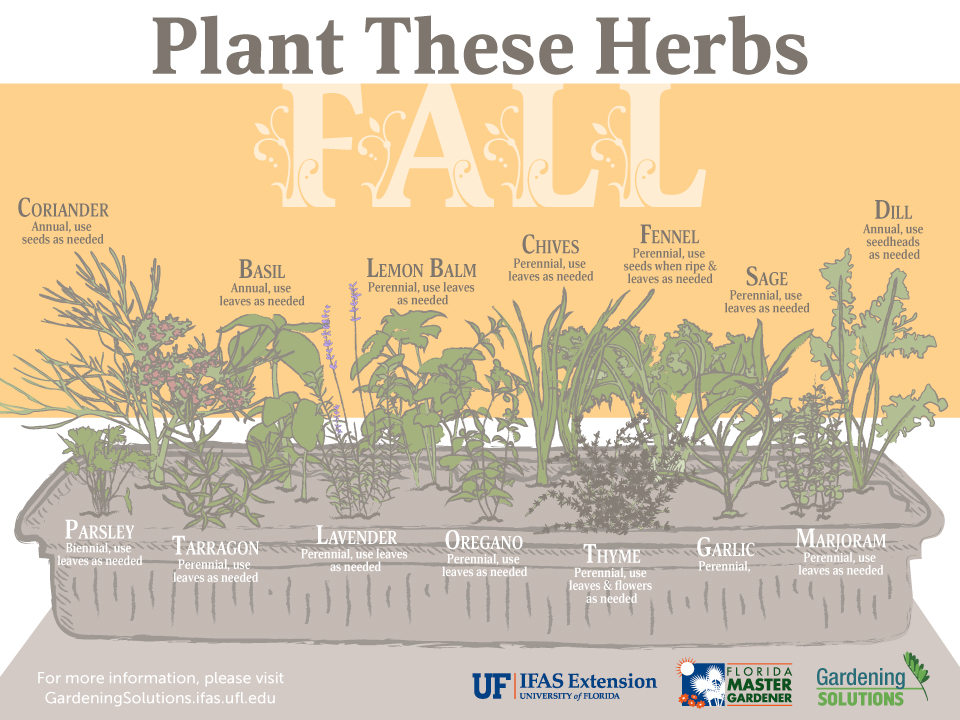By: Khadejah Scott
Extension Agent, Horticulture/Agriculture/Natural Resources
UF/IFAS Extension Wakulla County
It is common for homeowners to have to pick between design and function when planning their fall landscape. However, combining the two can result in a stunning display in the yard. In North Florida, several herbs do well in the cool weather of the fall. While herb gardens will always be famous, there are other understated, yet successful ways to incorporate herbs into the fall landscape this year. Herb gardening in the fall is not difficult; with a bit of forethought and creativity, you can use herbs to revamp an existing bed or create a brand-new one.
Herbs can be more than culinary specimens in the fall landscape. Herbs give a wide range of hues that enhance the landscape’s color, giving depth and contrast to your current garden. Fill the gaps around, between, and beneath your existing flowers to frame them without taking away from their beauty. The variety of herb foliage textures adds interest to your landscape; you can alternate between glossy, velvety, soft, and hairy surfaces. Many herbs also have insect-repelling qualities that aid in pest management. Meanwhile, the herbs also attract beneficial insects and pollinators to the garden, which are vital for the well-being and growth of other landscape plants.
One of the first stages of enjoying your garden is deciding its function. What and how you grow will be influenced by an end-use. For example, simple access to fresh herbs while you cook could mean planting them next to your back door. You want those vibrant flavors near your hand if you need a sprig. Space also needs to be considered while planning because plants will mature swiftly and flush out nicely, taking up more space. Each plant’s height and spread affects how much light it receives. Plant your more striking, upright herbs further back, giving plenty of room for low-lying, creeping herbs to be planted closer to the front where they may still receive sufficient light. At least six hours of direct sunlight each day are required for cool-season herbs. They will also need well-drained soil and adequate watering. Knowing each plant’s unique requirements can help homeowners care for herbs and identify unforeseen problems. Reinvent the way herbs have been grown in the past and incorporate their colors, textures, and blooms. For more information about planning your fall garden, contact your local UF/IFAS Extension Office.
Here are 5 ways to add cool season herbs to your fall landscape.
- Containers: Growing herbs in containers offers the flexibility of moving them. Potted herb gardens may be a perfect solution for small spaces like patios and balconies. Dill and fennel are great options for large containers.
- Groundcovers: Herbs that grow slowly and crawl, such as thyme, complement walkways and do nicely between paving stones.
- Borders: Herbs that form low mounds, such as oregano, make good borders, paths, and driveways.
- Low Hedges: Garden sage and other taller herbs create great low hedges that can aid in defining the boundaries of outdoor spaces.
- Softening Hardscapes: The billowing nature of cilantro and parsley herbs makes them perfect candidates for softening the hard edges of stone and concrete.
- Doveweed Control in Centipedegrass Lawns & Landscaped Beds - June 5, 2025
- Another Plea to End Crape Murder - April 21, 2025
- Roadside Red Blooms – Red Maples Showing Off This Spring - March 6, 2025

